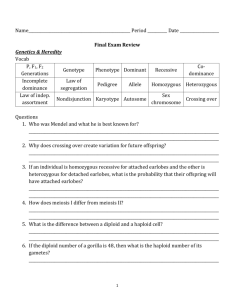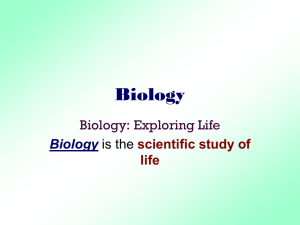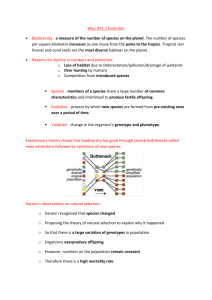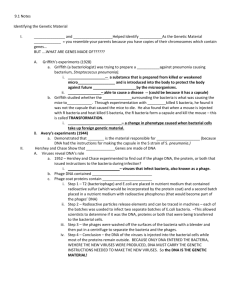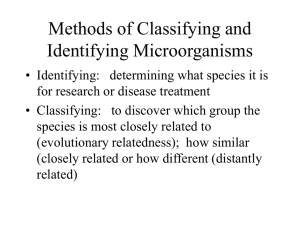8. Viruses are classified as ______ ______ . Obligate intracellular
advertisement
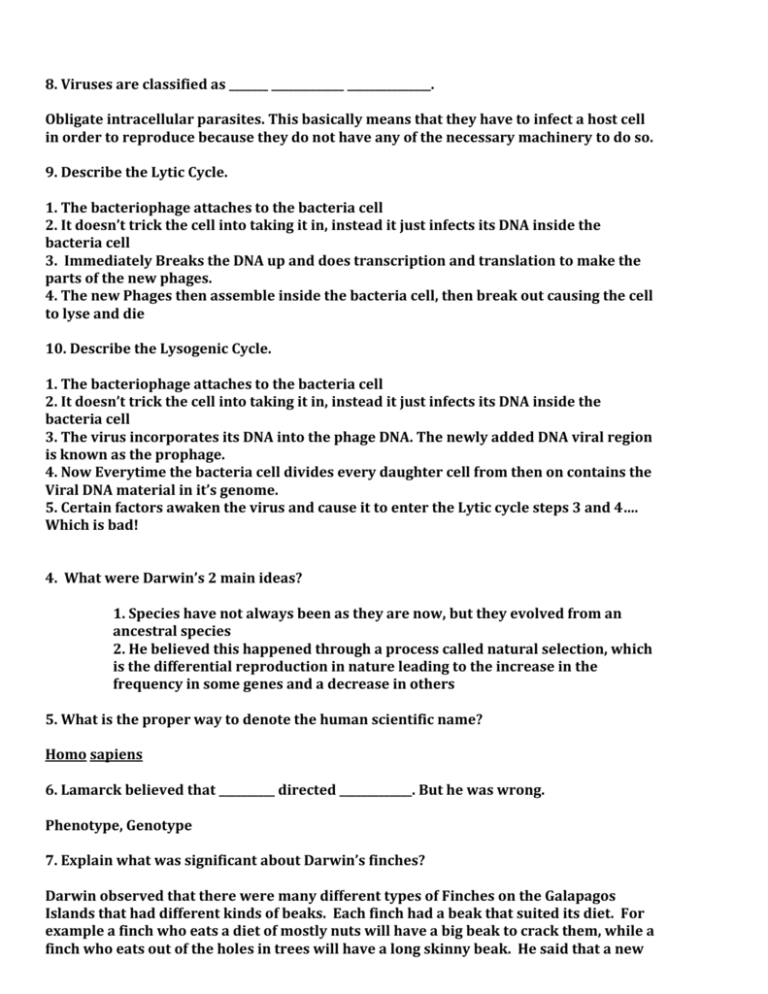
8. Viruses are classified as _______ _____________ _______________. Obligate intracellular parasites. This basically means that they have to infect a host cell in order to reproduce because they do not have any of the necessary machinery to do so. 9. Describe the Lytic Cycle. 1. The bacteriophage attaches to the bacteria cell 2. It doesn’t trick the cell into taking it in, instead it just infects its DNA inside the bacteria cell 3. Immediately Breaks the DNA up and does transcription and translation to make the parts of the new phages. 4. The new Phages then assemble inside the bacteria cell, then break out causing the cell to lyse and die 10. Describe the Lysogenic Cycle. 1. The bacteriophage attaches to the bacteria cell 2. It doesn’t trick the cell into taking it in, instead it just infects its DNA inside the bacteria cell 3. The virus incorporates its DNA into the phage DNA. The newly added DNA viral region is known as the prophage. 4. Now Everytime the bacteria cell divides every daughter cell from then on contains the Viral DNA material in it’s genome. 5. Certain factors awaken the virus and cause it to enter the Lytic cycle steps 3 and 4…. Which is bad! 4. What were Darwin’s 2 main ideas? 1. Species have not always been as they are now, but they evolved from an ancestral species 2. He believed this happened through a process called natural selection, which is the differential reproduction in nature leading to the increase in the frequency in some genes and a decrease in others 5. What is the proper way to denote the human scientific name? Homo sapiens 6. Lamarck believed that __________ directed _____________. But he was wrong. Phenotype, Genotype 7. Explain what was significant about Darwin’s finches? Darwin observed that there were many different types of Finches on the Galapagos Islands that had different kinds of beaks. Each finch had a beak that suited its diet. For example a finch who eats a diet of mostly nuts will have a big beak to crack them, while a finch who eats out of the holes in trees will have a long skinny beak. He said that a new species would arise from an ancestral form by the gradual accumulation of adaptation to different environments. 8. What were Darwin’s 4 pillars for natural selection? 1. Variation – mutation, genetics 2. Competition – compete for limited resources 3. Survival to reproduce – you’ve got to be alive to pass on your genetic information 4. Overpopulation – species produce more offspring than will survive 9. What are the 5 main pieces of evidence to support Darwin’s theory of evolution? A. Fossil Evidence – Basically taking a look down into the rock layers can tell you a lot about the past. The deeper you go down into the rock you will find older organisms like “only prokaryotes.” Come closer to the surface of the rock and you will see vertebrates and such. B. Comparative Anatomy – Take a look at the bones in mammals arms, you will notice similar groupings of bones all the way from a whale to a bat. Homologous structures are similar in function and arose from a common ancestor. Analogous structures like a bat wing and an insects wing have similar function but did not arise from a common ancestor. C. Comparative Biochemistry and Molecular Biology – Everybody uses ATP, everyone shares a similar genetic code, glycolysis. D. Comparative embryology – chicken embryo and a human fetus look startlingly similar. Both have tails for instance. E. Biogeography – “the geographical distribution of species” Convergent Evolution – independent development of similarities between species as a result of their having similar ecological roles and selection pressures – sugar gliders and flying squirrels. 10. Evolution works at a ___________ level. Population level, not an individual level 1. What are the 3 types of selection? a. Directional selection – moves away from the mean because of a change in environment.. can either move to the right or the left. b. Destructive selection – 2 very distinct phenotypes are kept while the middle phenotype is mostly irradiated. Creates a dimorphic population. A white beach with black lava. c. Stabilizing selection – the environment has not changed for a long time so the population mean because very centralized an stabilized to the middle phenotype. 2. What are the 3 ways species KEEP variation? a. Diploidy – natural selection cannot select against something that is hidden in the heterozygous form in the genome. Recessive alleles can stay hidden. b. balanced selection – heterozygous advantage…. Frequency dependent selection. c. neutral selection – If the characteristic is not necessarily better or significantly worse than the best phenotype, we just keep it in the gene pool, for example blue eyes. 3. Define – a. fitness – an individuals probable genetic contribution to succeeding generations. b. coevolution – When 2 organisms are biologically dependent on each other, they normally evolve together. For example a humming bird and a long tubular flower. c. Allopatric speciation –A population forms a new species while geographically isolated from its parent population. d. Sympatric speciation - A subset of the population forms a new species without geographic isolation. e. Habitat – Kind of environment an organism lives : mountains, plains, desert, tundra f. Cline – Character of a species shows a gradual variation coordinating with geography. g. Bergmann’s Rule – average body size gets larger as climate get’s colder… increasing size decreases surface area and saves heat f. Alan’s Rule – Extremities of organisms get shorter with colder climates g. deme – small local population h. Range – geographical area where members of a species are 4. What are the 4 reasons we don’t have perfect organisms? a. Organisms are locked into historical constraints and can’t make genes on command. b. Adaptations are often compromises c. Not all evolution is adaptive, it could be chance d. Selection can only edit, it cannot create 5. What is the difference in anagenesis and cladogenesis? Anagenisis is when one species changes into another species. Cladogenesis is when one species diverges into a new species and also retains it’s old species, so A goes to A and B 6. What are the Pre and Post zygotic barriers? Name them. PRE a. Habitat Isolation – mate in different places. b. Temporal isolation – mate during different seasons or times c. behavioral isolation – distinct rituals between organisms of the same species prevent interbreeding. d. mechanical isolation – things just don’t fit properly e. gametic isolation – sperm and egg wont fertilize because they are too different POST a. reduce hybrid viability – dies as an embryo and if it survives it is very weak b. reduced fertility – the offspring is sterile.
